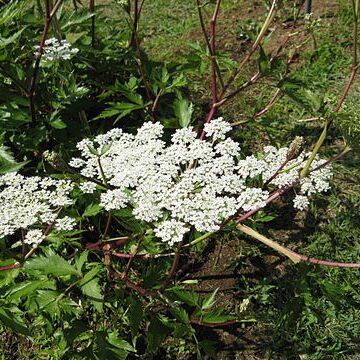Plants perennial, 30–100 cm. Root yellow-brown, 10–25 × 1–2.5 cm, strongly aromatic. Stem solid, purplish, thinly ribbed. Basal and lower leaves petiolate, petioles 10–30 cm, sheaths oblong; blade triangular-ovate, 10–25 cm, 1–2-ternate-pinnate, glabrous; pinnae short-petiolulate, 2–9 × 1–3 cm, 3-lobed, segments lanceolate, margin irregularly acute-serrate, apex acuminate to acute; peduncles 5–20 cm, glabrous or pubescent; bracts absent or 1 to several, linear-lanceolate, 1–2 cm; rays 18–30, unequal, pubescent; bracteoles 5–8, linear, 5–15 mm; umbellules ca. 30-flowered; pedicels slender. Calyx teeth obsolete. Petals white, obovate to oblong. Fruit narrow-oblong, 4–5 × 1–1.5 mm; dorsal ribs filiform, lateral ribs narrow-winged; vittae 3–4 in each furrow, 4–8 on commissure. Fl. Jul–Aug, fr. Aug–Sep.
More
A herb. It keeps growing from year to year. It can grow 70 cm high. The stems are reddish to purple. They have thin ribs. The leaves are deep green and arranged alternately. The upper leaves are oblong and with teeth. Lower leaves have lobes. These can be 2-9 cm long by 1-3 cm wide.

